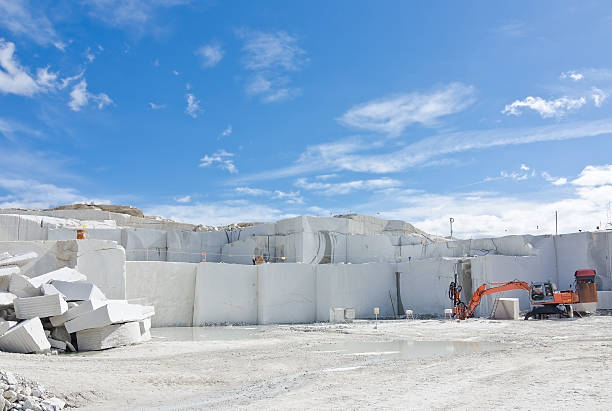Uncovering the Rich Background and Lasting Practices of Granite Quarrying
As we base on the precipice of uncovering the detailed tapestry of granite quarrying, a journey via time discloses not simply the physical act of extracting rock however additionally the social and historical importance woven right into the really material of this technique. From the old beginnings that laid the structure for modern quarrying strategies to the lasting techniques that are forming the future of this sector, each chisel mark on granite surfaces narrates waiting to be unearthed (granite quarries in south africa). The tradition of granite quarrying extends far beyond simple removal; it is a testament to human ingenuity, durability, and the long-lasting allure of this majestic stone
Old Beginnings of Granite Quarrying
Dating back to ancient worlds, the method of quarrying granite has actually been an essential part of human history and architectural innovation. The earliest proof of granite quarrying days back to old Egypt, where massive pyramids and complex sculptures were crafted from this sturdy rock. The Egyptians made use of primitive tools to remove granite blocks from quarries, showcasing the importance of this product in their huge constructions.
Progressing in history, the Greeks also made considerable payments to the quarrying of granite. The Greeks utilized granite in different architectural wonders, such as holy places and statuaries, demonstrating their skill in shaping and carving this hardy stone. The Romans better refined the techniques of quarrying granite, employing advanced tools like chisels and hammers to essence and shape granite for their renowned structures.
Through the centuries, the technique of quarrying granite has actually evolved, with modern technologies boosting performance while preserving the ageless charm of this natural stone - granite quarries in south africa. From old human beings to modern builders, the heritage of granite quarrying remains to form our world
Evolution of Quarrying Strategies
The advancement of quarrying strategies has been noted by a constant progression in the direction of higher efficiency and precision in removing granite. From the simple techniques employed by our ancestors to the advanced technologies utilized in contemporary quarrying operations, the sector has gone through significant improvements. Early quarrying strategies included manual work with fundamental tools such as knives, hammers, and wedges to extract granite blocks from the planet. As human beings advanced, strategies like fire-setting and primitive dynamites were presented to help with the removal procedure.
In more recent times, the development of equipment reinvented the quarrying sector, enabling quicker removal rates and boosted performance. Technologies such as diamond cable saws, high-pressure water jets, and pneumatic drills have actually ended up being conventional in modern-day quarries, enabling for exact cutting and decreased waste. In addition, advancements in computer-controlled devices and 3D modeling have maximized quarrying procedures, bring about minimal environmental impact and boosted sustainability practices. As the need for granite proceeds to climb, the evolution of quarrying techniques remains essential to meeting market requires successfully and sustainably.
Cultural Importance of Granite
Granite holds a profound social significance throughout numerous human beings because of its enduring visibility in building work of arts and respected monuments. From the marvelous pyramids of Egypt to the complex makings of the Angkor Wat holy place in Cambodia, granite has actually been a material of choice for sharing magnificence and durability find more info in social heritage. In ancient Rome, granite columns adorned holy places and public structures, symbolizing strength and durability. The cultural significance of granite expands past its physical characteristics; it embodies strength, stability, and eternity, making it a symbol of sustaining traditions and traditions.

Sustainable Practices in Quarrying
Amidst the abundant background of granite quarrying and its social significance exists a growing emphasis on lasting practices within the sector. As environmental awareness and concerns concerning resource deficiency have actually heightened internationally, the quarrying industry has actually progressively embraced lasting methods to lessen its influence on the environment and bordering communities.

Moreover, recovery and recovery of quarry websites post-extraction are important to lasting techniques. By bring back quarried locations to a natural or beneficial state, such as creating wild animals environments or entertainment areas, quarriers can counter the ecological footprint of their operations and add favorably to the regional ecological community.
Heritage of Granite Quarrying
With a historic background steeped in craftsmanship and commercial progression, what sustaining influence has granite quarrying left on the landscape of modern-day society? The legacy of granite quarrying goes beyond plain removal techniques; it has formed building marvels, city landscapes, and social heritage worldwide. The resilient nature of granite has made it a preferred selection for monuments, buildings, and framework, standing as a testimony to the skill and creativity of quarry workers throughout generations.
In addition, the financial footprint of granite quarrying can not be overlooked. The sector remains to offer employment possibilities and drive regional find this economies in areas where granite removal prevails. It has actually also stimulated technological innovations in quarrying methods and equipment, leading to a lot more efficient and lasting practices.
In regards to sustainability, the tradition of granite quarrying includes efforts to alleviate ecological impacts with recovery tasks and accountable source monitoring. By balancing economic rate of interests with ecological stewardship, the sector strives to ensure that future generations can remain to benefit from this enduring natural deposit.
Final Thought
